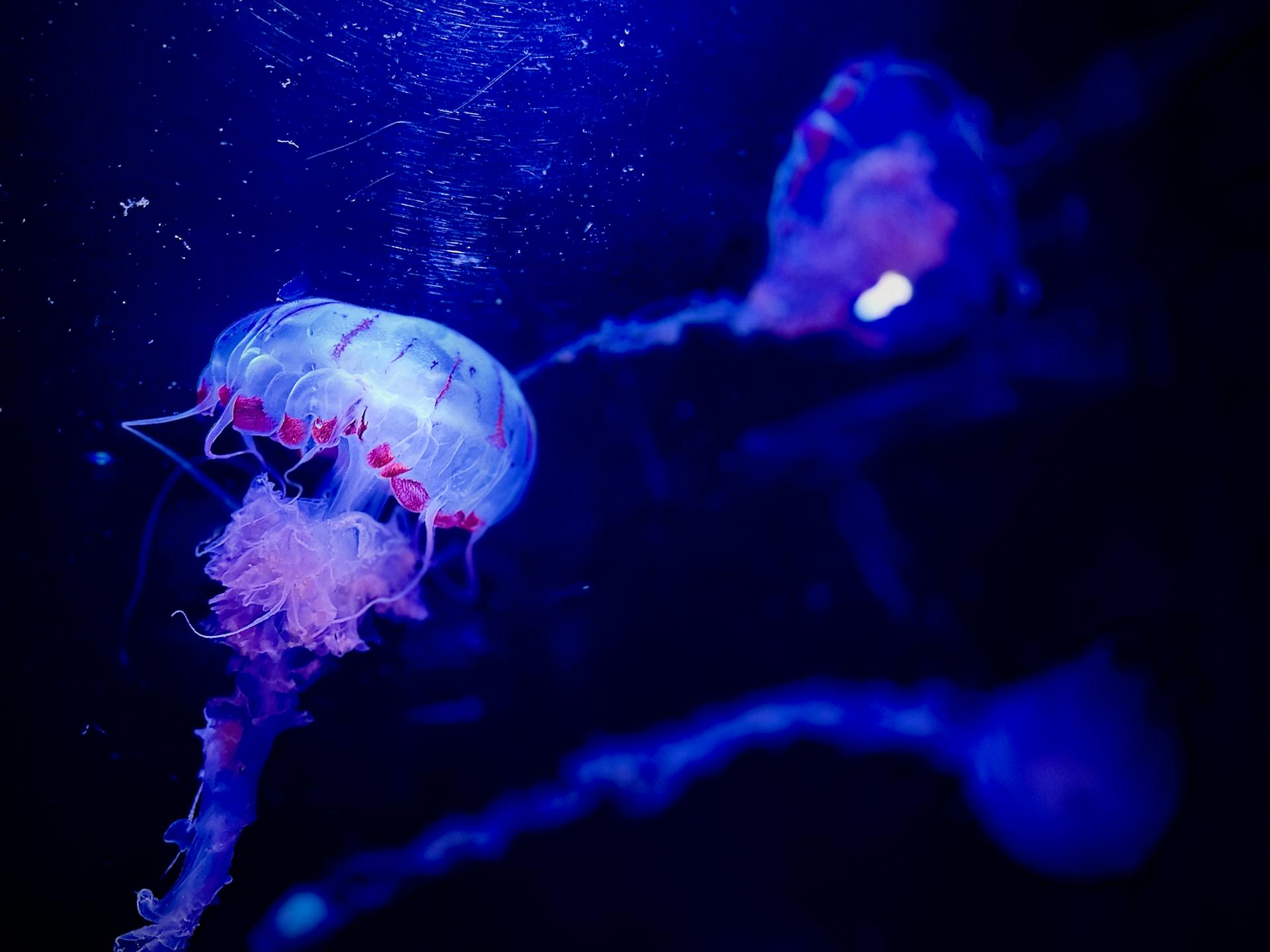
The debate surrounding Blue Heelers with docked tails has been a contentious issue for many dog owners and breeders. The American Kennel Club (AKC) recognizes the Blue Heeler breed with a natural tail.
Docking a Blue Heeler's tail is a surgical procedure that involves amputating the tail, which can be performed for various reasons, including to prevent injury or to conform to breed standards. The American Veterinary Medical Association (AVMA) states that tail docking is a cosmetic procedure with no proven health benefits.
In some countries, tail docking is banned or heavily regulated due to animal welfare concerns. The Australian Veterinary Association (AVA) has taken a stance against tail docking, citing the potential for harm and the lack of scientific evidence to support its practice.
Broaden your view: Blue Heeler Breed Origin
Docking Process
The docking process for a blue heeler's tail is a surgical procedure that involves amputating a portion of the tail. This is typically done on three- to five-day-old puppies without anesthesia.
The length of the docked tail varies depending on the specific breed, with some breeds, like the Pembroke Welsh Corgi, calling for tails to be docked as short as possible without being indented. The Wire Fox Terrier standard, on the other hand, calls for a three-quarter dock.
The procedure involves measuring the puppy tail and making the amputation between the appropriate vertebrae. This is done under sterile conditions by a veterinarian familiar with breed standards.
Recommended read: Miniature Schnauzer Tail Docking
Potential Complications
Neuromas are painful, swollen bundles of nerve fibers that attempt to regrow at the amputation site, causing severe pain and leading to mutilation and infection.
Dogs that develop neuromas often need to undergo surgical removal, but there's a risk of recurrence if not all the nerve tissue is removed the first time.
Removing part of a dog's tail can affect their locomotion, making it harder for them to balance on land and while swimming.
Tail docking can even contribute to urinary and fecal incontinence, according to veterinarian Robert Wansborough.
Neonatal puppies are fragile and susceptible to medical issues, including infections, making unnecessary physical trauma like tail docking particularly ill-advised.
Some puppies have died from shock and/or blood loss during the procedure, highlighting the risks involved.
Tail docking can disrupt a dog's ability to communicate with other dogs, leading to stress and behavioral changes.
Research suggests that dogs are more likely to approach a robotic dog with a long, moving tail, indicating a friendly invitation to play.
Expand your knowledge: Lab Blue Heeler Puppies
Australian Cattle Care
The Australian Stumpy Tail Cattle Dog has a weather-resistant coat that requires little maintenance to keep it well conditioned.
Grooming your blue heeler docked tail dog weekly with a metal comb and bristle brush or a slicker brush will remove any dead or loose hairs.
He is a seasonal shedder and when he is shedding heavily, plan to groom him more often, probably once a day until all the undercoat has come out.
He will shed heavily twice a year depending on climate.
His hair should fall out in clumps similar to that of a Collie.
Clean his ears weekly and check for any irritation or redness that might mean a slight infection is brewing.
Your blue heeler docked tail dog will probably only need to be bathed twice a year when he is shedding.
This helps loosen the undercoat and hasten the shedding process.
He needs a lot of room to run and play, making him not ideal for an apartment setting or a small yard.
He also needs a fenced yard if he is not in charge of a herd of livestock or he will be running at large through the neighborhood.
He has such a strong herding instinct, if he is not being used to work cattle or other livestock, he may become extremely unhappy and destructive.
Broaden your view: How Much Exercise Does a Blue Heeler Need
Docking Controversy
The docking controversy is a topic that's been debated for a long time. The American Veterinary Medical Association opposes ear cropping and tail docking when done solely for cosmetic purposes.
In fact, a number of veterinary clinics, including Banfield Pet Hospitals, have stopped tail docking and ear cropping altogether. This is a significant shift in the industry.
The practice is considered inhumane by dog registries in Europe. This is a clear indication of the controversy surrounding tail docking.
Some veterinarians believe that docking may predispose dogs to urinary incontinence later in life. This is a potential risk that pet owners should be aware of.
Docking a dog's tail cuts off tail talk to a great extent, which could cause communication problems between dogs. This is a concern that's worth considering.
Worth a look: Blue Heeler as a Pet
Summary
Blue Heelers are a popular breed of dog known for their intelligence and energetic personalities. They're often docked, which means their tail is surgically shortened.
Their tails are typically docked when they're just a few days old, and the procedure is usually performed by a veterinarian. This is done to prevent injury to the tail, which can happen when they're working on farms or ranches.
The docking process is relatively quick and easy, with most dogs recovering within a few days. Blue Heelers are generally healthy dogs, but docking their tails can reduce the risk of injury to the tail.
Their tails are also docked to prevent the risk of tail injuries, which can be painful and potentially lead to infection.
Related reading: Breeds of Dogs with Docked Tails
Frequently Asked Questions
Can blue heelers be born without tails?
Yes, blue heelers can be born without tails due to a genetic variation in the T gene that affects tail development. This congenital condition is known as a bobtail trait.
Sources
- https://www.themeateater.com/hunt/upland-birds/docking-tails-is-puppy-pain-worth-the-gain
- https://www.goodpetparent.com/2015/03/27/tail-docking-dogs/
- https://www.thesprucepets.com/puppy-tail-docking-2804964
- https://wagwalking.com/breed/australian-stumpy-tail-cattle
- https://www.pawprintgenetics.com/products/tests/details/175/
Featured Images: pexels.com


